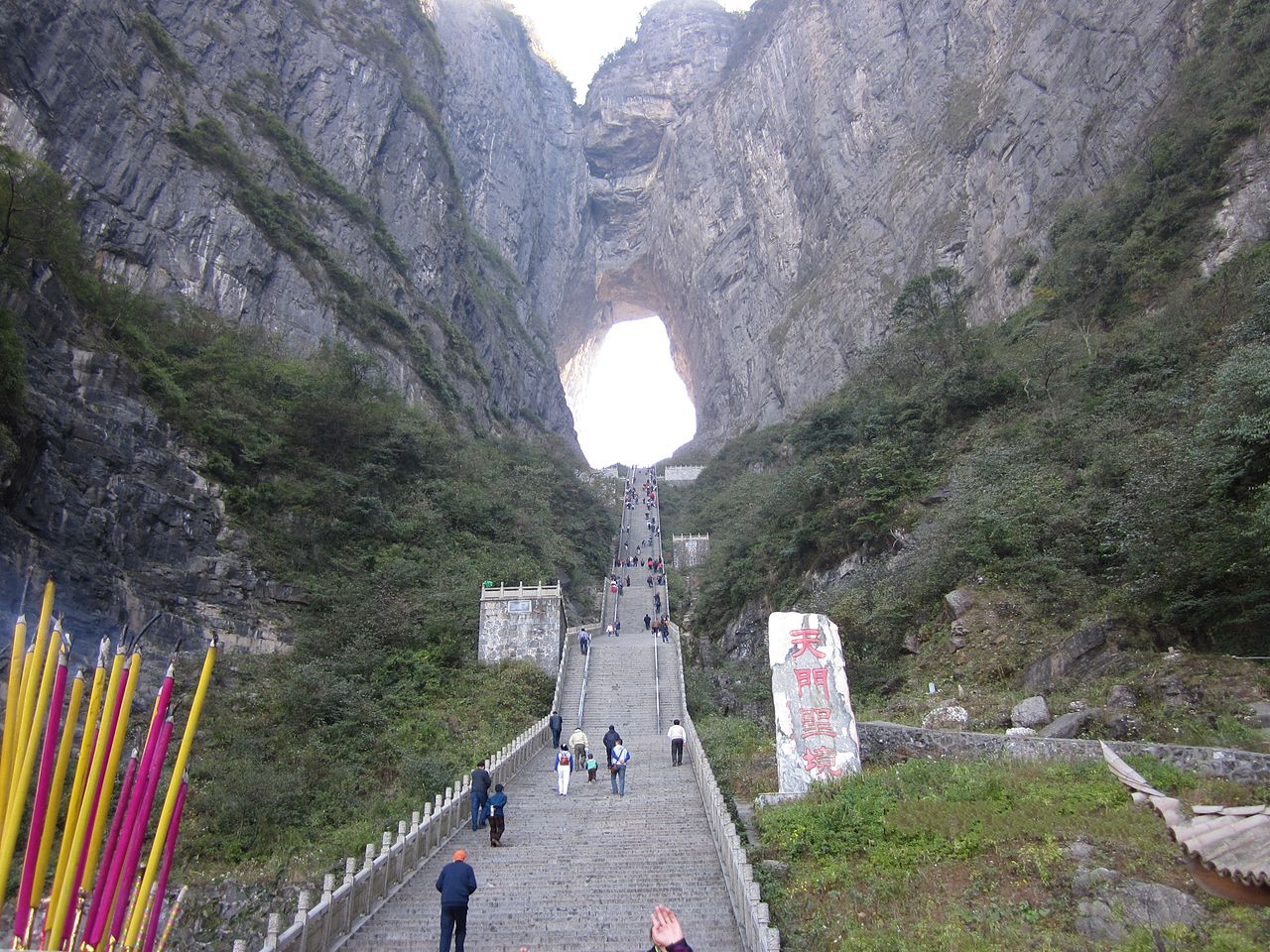7 So again Jesus said to them, “Very truly, I tell you, I am the gate for the sheep. 8 All who came before me are thieves and bandits, but the sheep did not listen to them. 9 I am the gate. Whoever enters by me will be saved and will come in and go out and find pasture. 10 The thief comes only to steal and kill and destroy. I came that they may have life and have it abundantly. [John 10:7-10, NRSV]
[L] The Tianmen (Heaven’s Door/天门) road. [R] Tian Menshan Mountain, Zhangjiajie, China.
“Doors to the sacred” as a title is by no means new or original. It is the title given by Joseph Martos to his systematic work on the historical background and development of the seven sacraments. Our focus here is however much more modest and specific. We shall be taking a passing glance at the RCIA (the Rite of Christian Initiation of Adults) and tag on some elements for reflections towards Christian living.
The theme of Martos’s book reminds us of a story we once read about Y.N. Lam, a sixty year old writer from Hong Kong. Her biography boasts of a life that was anything but dull. She has been an unwed teenage mother, a divorced single parent, an attractive high-flying socialite – altogether a very ‘wild’ life – before she settled down at a more mature age to become an author struggling with many social issues of her day. Once, during the brief dialogue time at a Buddhist silent retreat, the retreat master asked her, “Where do you come from?” Eager to display her depth, she raced mentally to conjure up some impressive philosophical ideas but finally settled on this: “I come from my mother.”
Wrong answer, try again, the retreat master retorted and left her all confused for further meditation till the next meeting.
“I come from Hong Kong,” she reported the next time round. Wrong, meditate some more, the monk told her and left.
Told bluntly that she was “wrong” twice in response to such a simple question as “where do you come from,” her ego was dented and worse, her confidence was shaken. Finally, she gave up being sophisticated and intellectual and at the next meeting, she told the monk, quite simply, “I came in through that door.” “You have arrived,” the monk told her. “You may leave now.”
That’s it. The door!
The door symbolizes a break with another world. Through it, she had entered another world, a world of peace. Let go of the world of strives, your world turns into peace and harmony. She had come to the retreat house seeking peace, her heart troubled by a world of intolerable suffering and evil. She came from that road, that journey, and she came in through that door – a journey; a door. Though there was no prize for giving the right answer, that conversation with the Buddhist monk was revelatory for her. It taught her not to dwell endlessly on personal problems and conflicts for, the more we dwell on them, the more messy they become. It’s all part of life’s journey, a journey full of ups and downs, and by its very nature is filled with joy and hope, grief and anguish. Find that door, walk through to peace.
If we were asked the same question by the retreat master, how would we have responded? We suspect our answer might be closely related to hers, and yet quite different. And the difference would precisely have been due to our Christian theological formation. As Christians, we tend to imagine life as a journey and even more so, as a pilgrimage, at the end of which we hope, as all Christians do, to meet the Lord face to face. So we would have said, “We came in by the road.” At one point on that road, we chose to go for baptism as adults. Then we entered by a particular door – the door of Christian initiation of adults – the door to the sacred.
Life is full of transitions and intersections. There are many doors at different stages of our lives. A teenager has to choose further academic studies or vocational training. This is followed by job-hunts. As a matter of fact, many today do not stay in one job for life. Then, there is the familiar journey of boy choosing girl and girl choosing boy, of entering into married life or staying single by circumstances or by design, or even choosing religious life. While many embrace a specific religion, many others go through life without ever explicitly choosing a religious faith or, if they have chosen one, they vacillate between a few, and living some kind of syncretic religious existence.
Often too, we walk through some of these doors without thinking. Some do so because the other choices are simply not available. On the other hand, there are those who wander, hesitate, and pace the floor outside certain doors, unable to decide. The fact is, we never have all the answers to questions on what lie ahead after we have walked through the door. And because of hesitation and indecision, many miss their golden opportunities and live to regret them.
We have beautiful thoughts about what lie beyond, at the other side of the door. The fact is, we cannot see beyond the door. Enter it we must, if we want to truly see and experience it for ourselves. It is truly an adventure. Despite the inevitable uncertainties, we are not walking alone, in fear. We have the Holy Spirit and the Lord, in his Word, in community worship, in the sacraments, and in communal fellowship. This is where experience is vital, over and above traditions, rules and doctrines. And experience never fails to point to the all-important community. In the “big” community, we feel that we belong. But it is in a “small” community, a small group of a few more close-knit regular friends and relatives, that the daily life is sustained.
What lies ahead for anyone who chooses to enter the door of baptism through the RCIA programme? We will begin the RCIA journey with the ancient catechumenate, the forerunner of our contemporary RCIA programme. Wherever this RCIA programme is run well, the whole parish will be transformed. To achieve that, however, the pastor and the RCIA team have to actively engage the parish community. This takes a lot of work and the path of least resistance is often preferred so as to “complete the programme” within specified time. By design, a significant sector of the faith community ought to be roped in to travel the catechumenal journey together with the catechumens. The catechumens themselves, of course, are supposed to be fired up to take the torch of serious Christian living as salt of the earth. But what does the report card say?
That is the question of the “morning after”.
The late Fr. Thomas Ivory, an expert in the RCIA programme, put it well: What happens after baptism is a serious matter. He saw the newly baptised as being commonly in danger of experiencing a serious let down, as the life after baptism could be a serious threat to their young faith. Ivory drew attention to the reality that needs addressing:
- existing tired and inefficient structures don’t change;
- existing senior believers lukewarm in faith practices don’t change;
- support groups are lacking;
- Sunday-Church-going is all there is that the newly baptized see “regular” Catholics do;
- a pervasive spiritual and religious indifference and lukewarm Christian life in the parish soon douses the fire on those who enthusiastically passed through the RCIA door.
Blessed are those observant RCIA ministers who direct the neophytes towards positive spiritual sustenance: choose a small Christian group to be an active part of; join a lay apostolate and take part in outreach work; light a candle instead of cursing the darkness and, above all, learn from Jesus of the Gospels. Jesus of Nazareth had no illusion about the full horror of human suffering. Filled with the Spirit, he became the compassionate and merciful face of the God of compassion and mercy and he taught his followers to be the same (Luke 6:36). In all that they do, the newly baptized are certain to be blessed with a joyous and grateful heart if they actively follow the Lord Jesus in the way of compassion and mercy.
Seek to encounter Jesus through dedicated Gospel reflection: select stories and seriously spend time in meditation, one story at a time. Once you have encountered the Lord Jesus in the Word, you will not stop, because you cannot stop! Join the two Emmaus disciples (Luke 24:12-35) who took up mission (again) after encountering the Risen Lord at the breaking of bread. They could not stop. Or partner the Samaritan woman at the well (John 4:1-38) who threw all cautions to the wind and went on to evangelise her village after she had encountered the Messiah.
You, too, will not allow the evil of the world and the inaptitude of the faith community to destroy in you the spirit of humble gratitude for what God has done for us in Jesus Christ.
Copyright © Dr. Jeffrey & Angie Goh, May 2023. All rights reserved.
To comment, email jeffangiegoh@gmail.com.


